
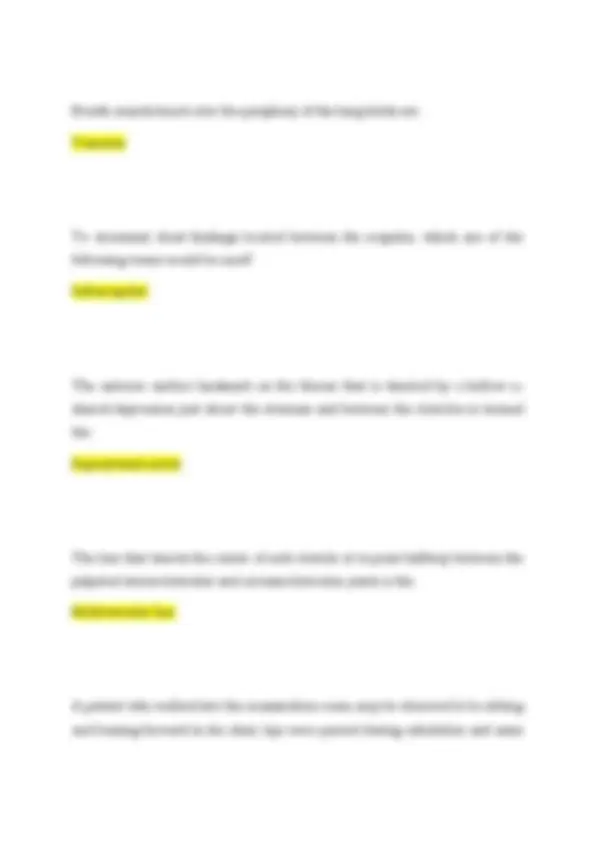
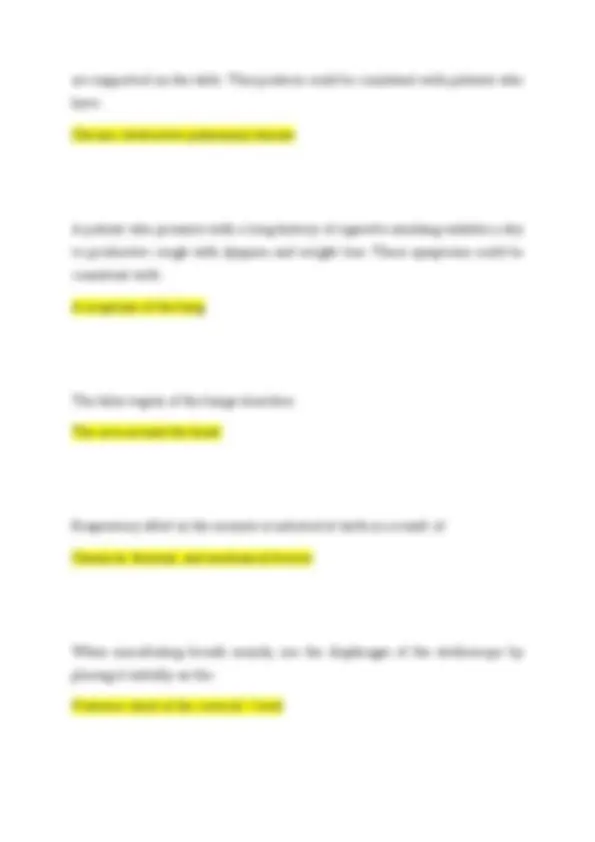
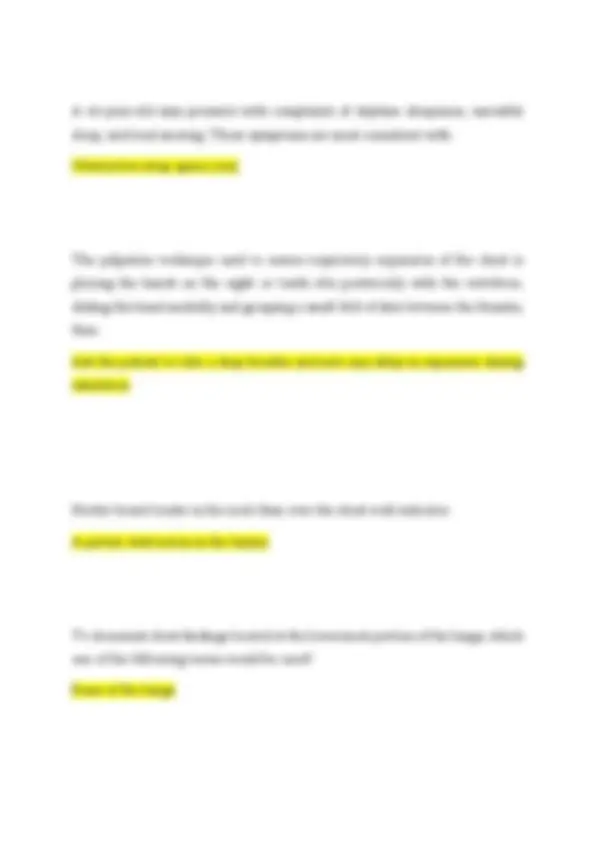
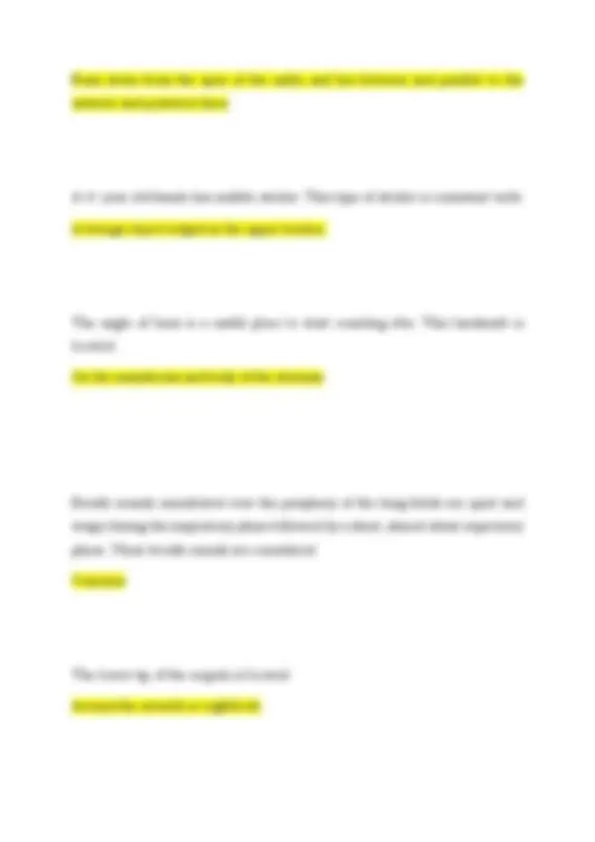

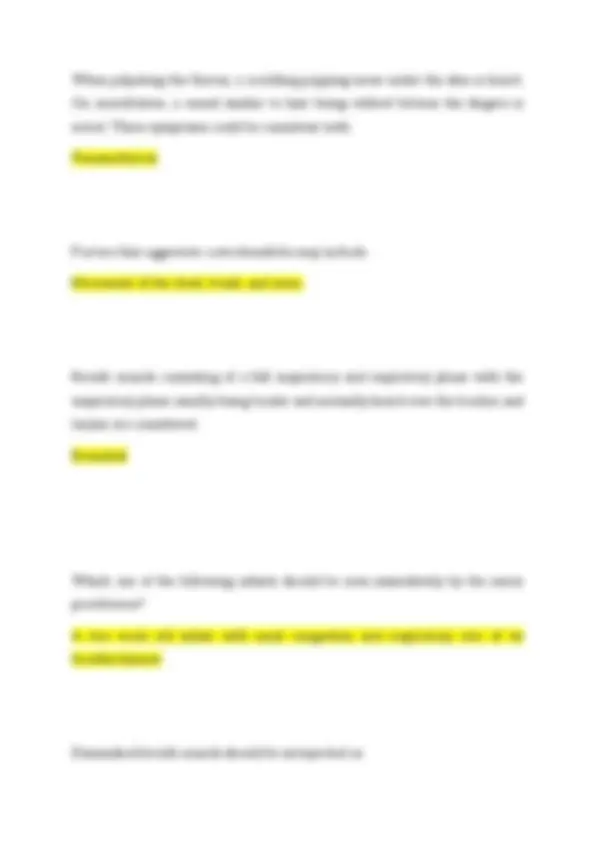


Study with the several resources on Docsity

Earn points by helping other students or get them with a premium plan


Prepare for your exams
Study with the several resources on Docsity

Earn points to download
Earn points by helping other students or get them with a premium plan
Community
Ask the community for help and clear up your study doubts
Discover the best universities in your country according to Docsity users
Free resources
Download our free guides on studying techniques, anxiety management strategies, and thesis advice from Docsity tutors
NSG6020 - RESPIRATORY | QUESTIONS AND ANSWERS | 2025-2026 | GRADED A+
Typology: Exams
1 / 12

This page cannot be seen from the preview
Don't miss anything!







To locate the twelfth rib, palpate: Between the spine and the lateral chest One of the anterior thoracic landmarks is the costal angle. It is locateed: Where the right and left costal margins form an angle where they meet at the xiphoid process When examining a patient for chest expansion, begin by: Placing the thumbs of the examiner at about the level of the tenth ribs with the fingers loosely grasping and parallel to the lateral rib cage A patient presents with a productive cough. Which one of the following descriptions of the mucus is correct? Tenacious sputum is consistent with patients who have cystic fibrosis
A 65-year old obese man with a past medical history of hypertension complains of increased fatigue during the day. The practitioner orders a polysomnogram to test for: Obstructive sleep apnea (osa) The middle section of the thoracic cavity containing the oesophagus, trachea, heart, and great vessels is the: Mediastinum When percussing the lower posterior chest, begin by: Standing on the side rather than directly behind the patient Orthopnea is typically associated with all of the following conditions except: Pulmonary embolus Which technique best determines whether the tissues in the chest are air-filled, fluid-filled, or solid? Percussion
are supported on the table. This position could be consistent with patients who have: Chronic obstructive pulmonary disease A patient who presents with a long history of cigarette smoking exhibits a dry to productive cough with dyspnea and weight loss. These symptoms could be consistent with: A neoplasm of the lung The hilar region of the lungs describes: The area around the heart Respiratory effort in the neonate is initiated at birth as a result of: Chemical, thermal, and mechanical factors When auscultating breath sounds, use the diaphragm of the stethoscope by placing it initially on the: Posterior chest at the cervical 7 level
A 65-year-old man presents with complaints of daytime sleepiness, unrestful sleep, and loud snoring. These symptoms are most consistent with: Obstructive sleep apnea (osa) The palpation technique used to assess respiratory expansion of the chest is placing the hands on the eight or tenth ribs posteriorly with the vertebrae, sliding the hand medially and grasping a small fold of skin between the thumbs, then: Ask the patient to take a deep breathe and note any delay in expansion during inhalation Stridor heard louder in the neck than over the chest wall indicates A partial obstruction in the larynx To document chest findings located at the lowermost portion of the lungs, which one of the following terms would be used? Bases of the lungs
When trying to differentiate between hemoptysis or blood streaked material, which one of the following observation is correct? Hemotysis is common in children with cystic fibrosis When percussing the posterior chest, which one of the following techniques would be omitted? Percuss the areas over the scapulae To document chest findings located below the scapulae, which one of the following terms would be used? Infrascapular/ interscapular Retractions are observed in the all the following areas except the: Hilar area The midaxillary line:
Runs down from the apex of the axilla and lies between and parallel to the anterior and posterior lines A 37 year old female has audible stridor. This type of stridor is consistent with: A foreign object lodged in the upper trachea. The angle of louis is a useful place to start counting ribs. This landmark is located: On the manubrium and body of the sternum Breath sounds auscultated over the periphery of the lung fields are quiet and wispy during the inspiratory phase followed by a short, almost silent expiratory phase. These breath sounds are considered: Vesicular The lower tip of the scapula is located: Around the seventh or eighth rib
When palpating the thorax, a crackling popping noise under the skin is heard. On auscultation, a sound similar to hair being rubbed betwen the fingers is noted. These symptoms could be consistent with: Pneumothorax Factors that aggravate costochondritis may include: Movement of the chest, trunk, and arms. Breath sounds consisting of a full inspiratory and expiratory phase with the inspiratory phase usually being louder and normally heard over the trachea and larynx are considered: Bronchial Which one of the following infants should be seen immediately by the nurse practitioner? A two week old infant with nasal congestion and respiratory rate of 64 breaths/minute Diminished breath sounds should be interpreted as:
An abnormal finding warranting further evaluation A deviated trachea could be caused by all of the following except: Pneumonia Adventitious breath sounds, such as crackles, are: Popping, frying sounds, may be low or high pitched and usually heard on inspiration Breath sounds heard on chest over the hilar region are: Bronchovesicular When inspecting the chest for respiratory effort, which one of the following is not part of the inspection? Assessment for tactile fremitus Increased anteroposterior diameter of the chest, purse-lipped breathing, and dyspnea with talking, suggest :